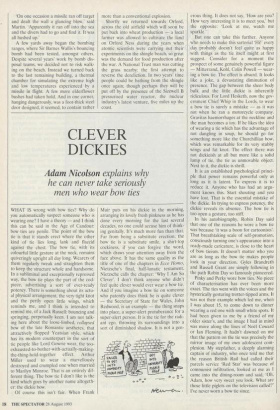CLEVER DICKIES
Adam Nicolson explains why
he can never take seriously men who wear bow ties
WHAT IS wrong with bow ties? Why do you automatically suspect someone who is wearing one? I have a theory — and I think this can be said in the Age of Candour: bow ties are penile. The point of the bow tie is that it stands erect where the other kind of tie lies long, lank and flaccid against the chest. The bow tie, with its colourful little gesture at the neck, remains quiveringly upright all day long. Wearers of them regularly tweak and straighten them to keep the structure whole and handsome. In a subliminal and exceptionally repressed way, the bow tie plays the part of the cod- piece, advertising a sort of ever-ready potency. There is something about its actu- al physical arrangement, the very tight knot and the pertly open little wings, which reminds me, and I think is intended to remind me, of a Jack Russell: bouncing and springing, perpetually keen. I am not talk- ing here about the loose-limbed, collapsed bow of the late Romantic aesthetes, that attractively flopped Yeatsian style, which has its modern counterpart in the sort of tie people like Lord Gowrie wear, the too- exhausted-to-bother-with-actually-making- the-thing-hold-together effect. Arthur Miller used to wear a marvellously destroyed and crumpled one when married to Marilyn Monroe. That is an entirely dif- ferent thing. The bow tie I don't like is the kind which goes by another name altogeth- er: the dickie bow.
Of course this isn't fair. When Frank
Muir puts on his dickie in the morning, arranging its lovely fresh pinkness as he has done every morning for the last several decades, no one could accuse him of think- ing genitally. It's much more fun than that. Far from being a substitute erection, the bow tie is a substitute smile, a shirt-top cockiness, if you can forgive the word, which draws your attention away from the face above. It has the same quality as the title of one of the chapters in Ecce Homo, Nietzsche's final, half-lunatic testament. Nietzsche calls the chapter: 'Why I Am So Clever'. I don't think anyone who didn't feel quite clever would ever wear a bow tie. And if you imagine a bow tie on someone who patently does think he is quite clever — the Secretary of State for Wales, John Redwood, is an example — the thing snaps into place, a super-alert protuberance for a super-alert person. It is the tie for the radi- ant ego, throwing its surroundings into a sort of diminished shadow. It is not a gen-
erous thing. It does not say, 'How are you? How very interesting it is to meet you,' but the opposite: 'Look at me, watch me sparkle.'
But one can take this further. Anyone who needs to make this sartorial 'Hi!' every day probably doesn't feel quite as happy with things as the tie itself might at first suggest. Consider for a moment the prospect of some genuinely powerful figure — Mitterrand, Kohl, Colin Powell — wear- ing a bow tie. The effect is absurd. It looks like a joke, a devastating diminution of presence. The gap between the sheer body bulk and the little dickie is inherently ridiculous. For Lord Hesketh, now the gov- ernment Chief Whip in the Lords, to wear a bow tie is surely a mistake — as it was not when he ran a motorcycle company. Gravitas haemorrhages at the neckline and the man becomes a toy. If he likes the idea of wearing a tie which has the advantage of not dangling in soup, he should go for something more like the Churchillian bow, which was remarkable for its very stubby wings and fat knot. The effect there was not dickieish at all but more like a solid lump of tie, the tie as unmovable object. Next to it, the dickie is shrill.
It is an established psychological princi- ple that power remains powerful only as long as it is latent. To express it is to reduce it. Anyone who has had an argu- ment knows this. Start shouting and you have lost. That is the essential mistake of the dickie. In trying to express potency, the dickie reveals its absence. The bow tie is too open a gesture, too stiff.
In his autobiography, Robin Day said that one of the reasons he wore a bow tie was because it was a boon for cartoonists'. That breathtaking scale of self-promotion, consciously turning one's appearance into a ready-made caricature, is close to the heart of bow tieism. It doesn't matter who you are as long as the bow tie makes people look in your direction. Gyles Brandreth and Russell Grant are simply following in the path Robin Day so famously pioneered.
Pinky and Perky wore bow ties. No piece of characterisation has ever been more exact. The ties went with the voices and the hysterically gesturing trotter-tipped arms. It was not their example which led me, when I was about 15, to come down to dinner wearing a red one with small white spots. It had been given to me by a friend of my older sister's, and the image I had in mind was more along the lines of Noel Coward or Ian Fleming. It hadn't dawned on me that the pattern on the tie was precisely the mirror image of my own adolescent com- plexion. My stepfather, a deeply alarming captain of industry, who once told me that the reason British Rail had called their parcels service 'Red Star' was because of communist infiltration, looked at me as came into the dining-room and said, 'Oh, Adam, how very sweet you look. What are those little piglets on the television called?' I've never worn a bow tie since.


















































 Previous page
Previous page